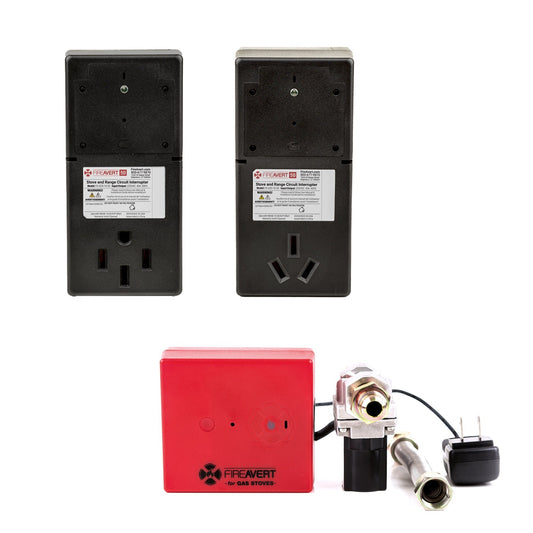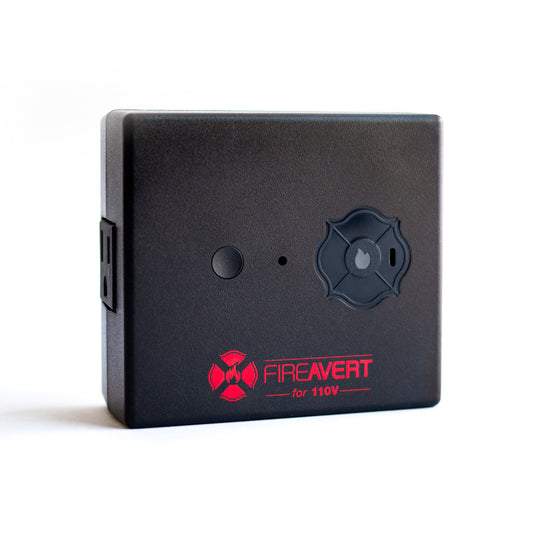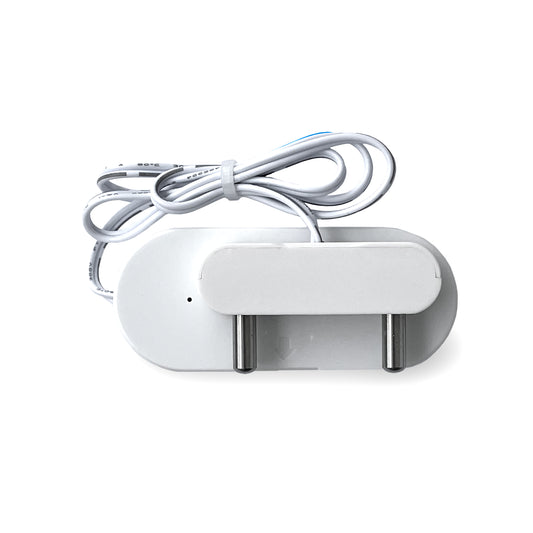Kitchen Fire Safety: 3 Rules + Tips to Stop Cooking Fires
Share

81% of Americans cook more than half their meals at home. That means over 500 million meals are cooked every single day! Knowing this, it's easy to understand why cooking is the number one cause of home fires.
Let's learn about cooking fires so you can prevent them from starting in your kitchen!
Need to put out a kitchen fire fast?
The 5 most common causes of kitchen fires
As we understand the causes of kitchen fires, we can start preventing them completely.
1) Unattended Cooking - 28%
Forgetting food on the stove caused 28% of kitchen fires. Sadly, it also led to 48% of the deaths related to cooking fires.
It is easy to forget you put something on the stove. But with these fires being so common, it is critical to home fire prevention to stay in the kitchen when you are cooking.
2) Discarded Materials - 10%
Often times cooking can lead to materials getting discarded from the pot or pan. These materials, if left, can lead to a kitchen fire.
Similarly to the first, being mindful of your cooking and staying in the room can completely prevent these fires.
3) Combustibles Too Close To Heat - 10%
Whether it's clothes or an oven mitt, anything easily combustible can catch fire if left too close to heat.
The simple '3-Foot Rule' can remove this fire risk from your home entirely.
4) Unclassified Misuse of Material - 9%
Misusing your cooking appliances or the materials you are cooking with can cause a kitchen fire.
By following the instructions of your appliances and practicing safe cooking, you can avoid this common cooking mishap.
5) Failure to Clean - 9%
Avoiding a fire in your kitchen is as simple as washing your dishes and cleaning your cooking station after use.
Old grease or food left near burners or on pots and pans can ignite suddenly. This can lead to grease fires and may quickly spread.
Essential kitchen safety rules
Kitchen fires make up almost half of all home fires. Creating and following kitchen safety rules can be a big step for home fire prevention.
By teaching your children these rules, they will build safe cooking habits they will keep forever. And by following these rules your self, you can stop kitchen fires.
Let's explore three simple kitchen safety rules:
- The 3-Foot Rule
- Stay & Watch
- Always Ready
The 3-Foot Rule
This rule means never place anything that isn't actively being used to cook food within 3 feet of your stove/oven.
If you are cooking on the stove with a pan and a spoon, those are the only items that can be placed within 3 feet.
Many common things we see breaking this rule are the next ingredients to be used and oven mitts. If your pot or pan overflows or you spill food, make sure to clean it up quickly!
By following the 3-Foot Rule you can prevent between 10%-29% of kitchen fires in your home.

Stay & Watch
This rule means if you have food cooking in the kitchen, you must be in the kitchen. This simple rule can prevent 28% of kitchen fires outright.
If you put food in the oven or crockpot, make sure to check on it periodically. NEVER leave the house with food slow cooking in your oven or crockpot.
Unattended cooking is too big a risk to try and increase your productivity by multitasking.
If you have to leave the kitchen for a moment you can remove a pan/pot from the heat on the stove while you are away.
Always Ready
The 'Always Ready' Rule is all about preparation. Fires can start suddenly, but if you are prepared you don't need to worry.
When cooking on the stove keep a lid nearby to snuff out any small flames or grease fires. Keep a working fire extinguisher and/or a fire blanket in your kitchen for larger fires.
Never assume a fire can be put out by water, always use a fire extinguisher or blanket. This is because grease fires (common in the kitchen) get bigger if you pour water on it.
Keep a working smoke alarm near your kitchen to alert you of any fires from slow cooking foods in the oven or crockpot.
Read our full smoke detector guide for more information about home smoke alarms.
Following these three simple rules can save you from an expensive and potentially dangerous home kitchen fire.
Must-have kitchen fire safety equipment
Having the right tools available to you in the event of a fire determines whether you have only a small flame or a full kitchen/home fire.
Here's our top recommended fire safety equipment:
| Equipment | Purpose | Key Feature |
|---|---|---|
| Smoke Detectors | Early fire warning | Install within 10ft of kitchen |
| Fire Extinguisher | Put out small-medium fires | ABC-rated, keep near kitchen |
| Fire Blanket | Smother grease fires | No expiration, easy to use |
| FireAvert | Automatic stove shutoff | Works with existing smoke alarms |
| HotDots | Burner heat indicator | Identifies which stove elements are on |
Smoke Detectors
Smoke detectors provide your first line of defense by alerting you to smoke or fire before it spreads.
For kitchens, it’s best to install them within 10 feet but not directly over cooking appliances to avoid false alarms.
Test them monthly and replace batteries yearly (or use sealed long-life models).
Fire Extinguisher
A kitchen fire extinguisher is essential for quickly putting out small to medium fires before they grow.
Look for an ABC-rated extinguisher, which covers most household fire types (including grease, electrical, and combustible materials).
Keep it mounted in an easily accessible spot, not hidden under the sink.
Fire Blanket
Fire blankets are perfect for smothering grease fires on stovetops or wrapping around someone if their clothing catches fire.
They don’t expire and are super simple to use — just pull it out, cover the flames, and leave it in place until the fire is fully out.
FireAvert
FireAvert is an automatic stove shutoff device that connects to your existing smoke detectors. When smoke is detected, it cuts power to the stove.
It’s a great extra layer of protection, especially for busy households or homes with kids or elderly family members.
It is also the only device on the market rated to prevent smoke damage as well as fire damage.
HotDots
HotDots are burner heat indicators that show which stove elements are turned on or still hot, helping prevent accidental burns or forgotten burners.
They’re a simple visual cue that adds another layer of safety to your cooking routine, especially in busy or distracted kitchens.
How to extinguish different kitchen fires
If you currently have a fire in your kitchen try these methods to quickly put it out.
Use a Fire Extinguisher -
- Pull the pin -This unlocks the extinguisher and allows you to discharge it.
- Aim low - Point the nozzle at the base of the fire, not the flames.
- Squeeze and sweep - Squeeze the handle and sweep the nozzle side to side until the fire is out.
Suffocate the flames - If you don't have a fire extinguisher, try suffocating the flames with a lid or fire blanket if your fire is in a pot or pan.
Use baking SODA (not powder) - If you have baking soda handy, try pouring it all over the base of the fire.
NEVER use water - You probably don't know what type of fire you have, but some fires can grow if you pour water on them.
Whatever method you use to extinguish the fire, turn off the heat as soon as you can to prevent reignition.

If you're just here to learn how to put out different types kitchen fires let's discuss that.
Grease Fires
Grease fires are tricky because they can't be extinguished with water. Pouring water on a grease fire will make it grow and could cause an explosion.
So how do you extinguish a grease fire?
As we said above, use a fire extinguisher or suffocate the flames with a lid, fire blanket, or baking soda.
Oven Fires
Fires in the oven can be tricky because there aren't typically open flames. The three steps you need to put out an oven fire are:
- Keep the door closed - Opening the oven door can lead to the fire spreading quicker.
- Turn off the heat - Turn off your oven to cool the contents inside and reduce the fire.
- Evacuate if necessary - Oven fires may spread uncontrollably if you don't catch them early. If this happens, get out of the house and call 911 ASAP and let the pros put out this larger fire.
Small Appliance Fires
If your microwave, toaster, or air fryer catches fire, make sure to unplug it quickly. This will often lead to the fire fizzling out quickly.
As with oven fires, never open the door or drawer on your microwave or air fryer as this will help the fire spread.
FireAvert also has a Small Appliance Shutoff Device to prevent these appliances from catching fire.
Educating yourself and your family about what to do in case of a fire is one of the best ways to prevent damaging or dangerous kitchen fires.
High risk situations
Some situations in the kitchen lead to a higher risk of fire. Here are some tips to deal with these risky situations.
Cooking With Kids/Pets Underfoot
- Keep a “kid-free zone” of at 3 feet around the stove. Remember the 3-Foot Rule.
- Use back burners when possible and turn pot handles inward to prevent tipping.
- Avoid holding babies or pets while cooking. Distractions increase the risk of accidents.
Holiday Cooking Overload
- Plan ahead and avoid overcrowding the stovetop or oven.
- Assign one adult to stay in the kitchen and supervise. No multitasking or running between rooms.
- Take short breaks if you’re cooking for long stretches to stay alert and avoid fatigue.
Late Night Snacks
- Double-check that all burners and appliances are turned off before leaving the kitchen.
- Avoid cooking if you’re overly tired or have been drinking alcohol.
- Consider using small appliances (like a microwave or air fryer) instead of the stove late at night for safer prep.
Preventing fires is better than putting them out and good preparation prevents fires in the kitchen.

Nobody wants to have a fire in their home. 48% of home fires start in the kitchen, which means following these cooking safety tips will prevent fires in your home.
To prevent the number one cause of fires get FireAvert and keep your home and family safe.




